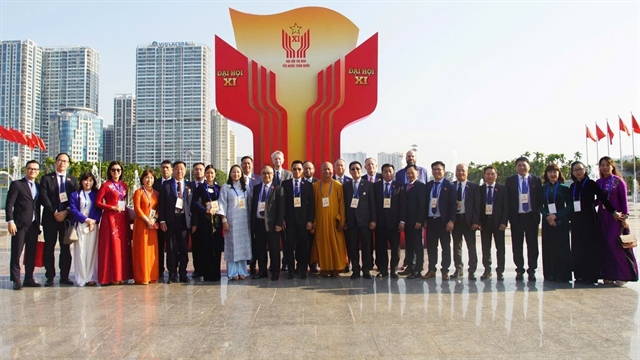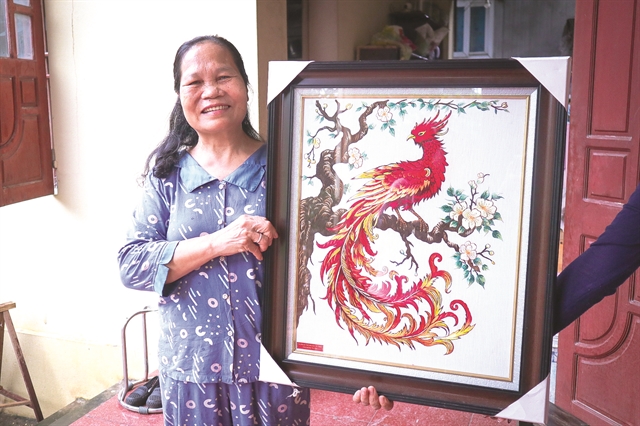 Features
Features

Let's explore some little known things in the country
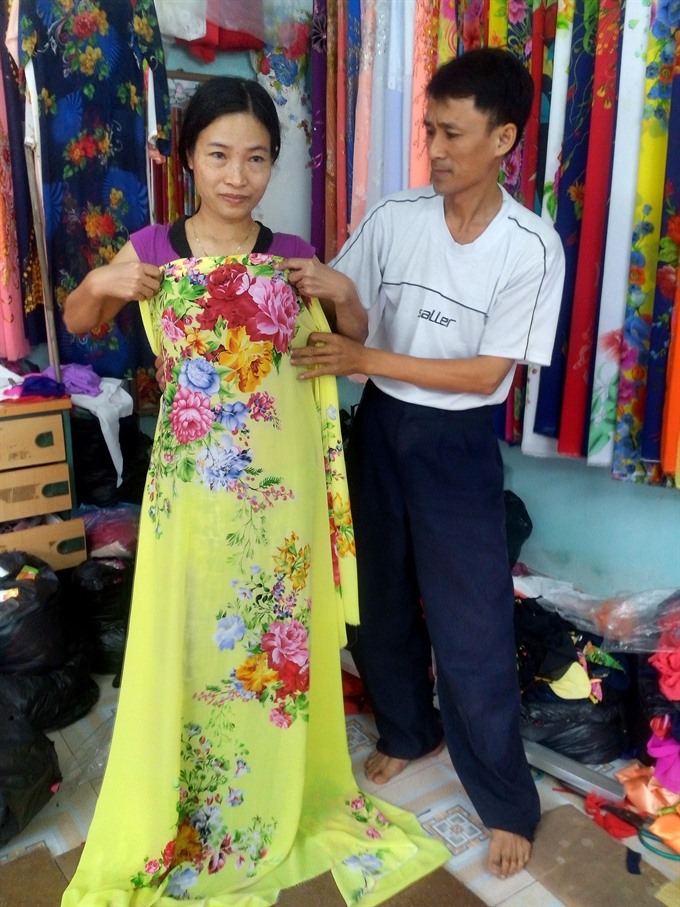 |
| Male bastion: For a very long time, only men were taught and allowed to make an áo dài in Trạch Xá Village.--VNS PHoto Đoàn Tùng |
Around 60km from downtown of capital Hà Nội, Trạch Xá Village in Ứng Hòa District has been known for making tradional long dress áo dài for centuries.
A strange feature of this fame, however, has been the fact that the iconic national dress for women was made exclusively by men.
To this day, 90 per cent of the local tailors are men, owing to a long-standing rule in the region: the job was taught only to men.
Explaining the special rule, Nguyễn Văn Nhiên, 84, who has been an áo dài maker for 65 years, said that in the old days, local inhabitants had to go far away to work as dress makers to earn their living. Only men could travel thus. Women were not believed strong enough to travel so often and so far, so they stayed at home to do housework and farm work.
Locals also believed that the áo dài designed and tailored by men was more beautiful than those done by women!
However, the craft was first taught to the village’s inhabitants by a woman.
Nguyễn Thị Sen, a concubine of King Đinh Tiên Hoàng (AD924 - 979) became the first dress maker in Trạch Xá after learning the craft from the King’s Palace in the northern province of Ninh Bình. She also taught tailoring to imperial maids. After leaving the Palace with her children, she returned to her nativeland, Trạch Xá, and taught the villagers how to sew. The reputation of the village travelled far.
A local man, Tạ Văn Khuất, had the honour of making a long dress for Queen Nam Phương, queen of the last feudal dynasty in Việt Nam.
Today, villagers do not have to travel to different regions to look for clients. Women also help their husbands do the job. Many clients go to the village to look for talented artisans who can make them the most beautiful áo dài.
Many villagers have also opened tailoring shops in Hà Nội. However, they include “Trạch” in the name of their shop, as tribute and advertisement for their native village’s craft.
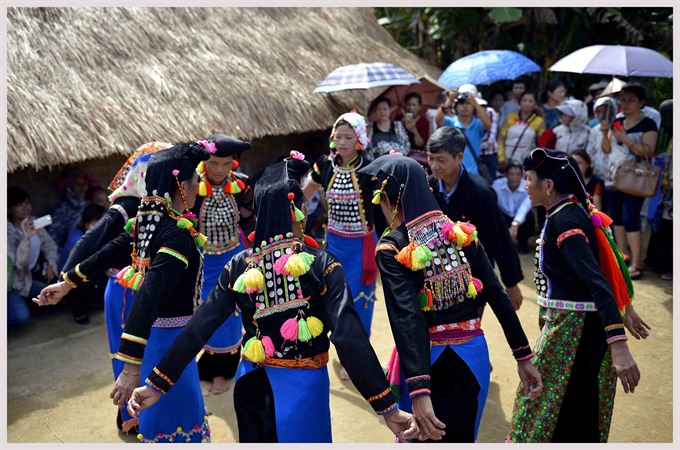 |
| Risk of extinction: Si La people enjoy a traditional festival. VNS Photo Xuân Tú |
The Si La ethnic group is among the smallest in number in Việt Nam. With a total population of fewer than 1,000, the Si La live mostly in Mường Tè District in the northen province of Lai Châu and in Mường Nhé District in the neighbouring province of Điện Biên.
The Si La’s language belongs to the Sino-Tibetan language family. But the language is spoken less and less and there is no written language.
Si La people say that hundreds of years ago, before settling down in Việt Nam, their ancestors lived in Lhasa, the capital of today’s Tibet Autonomous Region of China. They then migrated to Laos before coming to Việt Nam. They still remember a saying about their origin: "born in Lhasa, set up village in Laos".
Men in the group used to dye their teeth red, while women dyed their teeth black, but that custom has died out. The costumes of Si La women are made with metal coins attached to the chest. Their headscarves indicate their ages and marital status. Si La people customarily marry twice. The second ceremony is held one year after the first.
The group is at risk due to inter-marriage. Their bodies have become smaller over the generations. Average men weigh 40-45kg and stands 1.45-1.60m tall.
To confron the risk of extinction, in 2005 the Government implemented a five-year project to support the development of five ethnic minority groups with the smallest populations in Việt Nam, including the Brau, Rơ Măm, Pu Péo and Si La.
Lai Châu and Điện Biên provinces have upgraded local roads, provided clean water supply, opened schools, facilitated farming and health care, encourage traditional cutlure development like preserving language, costumes, musical instruments and belief of the Si La people.
The Si La’s lives have improved as a result, with roads linking their villages to larger population centres. All the houses have been roofed with sheet metal and the villages have been equipped with electricity to power lights, TVs and radios.
 |
| Rare space: The only mosque in northern Việt Nam, Al-Noor Masjid (The Mosque of Light) stands at 12 Hàng Lược Street in Hà Nội’s Hoàn Kiếm District. — VNS Photo Đoàn Tùng |
The only mosque in northern Việt Nam, named Al-Noor Masjid (The Mosque of Light), is located at 12 Hàng Lược Street in capital Hà Nội’s Hoàn Kiếm District.
Over the past 100 years, the mosque has been the destination for Vietnamese and foreign Muslim worshippers. At the beginning of the 19th century, Indian businessmen came to Việt Nam on business, and some settled here. In 1885 they started to build the Al-Noor mosque, which is therefore deeply influenced by Indian architecture and culture.
The mosque was officially inaugirated in 1890.
The main gate of the mosque faces West, in the direction of Islam’s holiest site in Mecca. It covers 400 square metres, with the decorations reminiscent of other mosques in the world. Prayers are held five times a day.
The mosque’s Imam (who leads the prayers) is Miêu Abbas, who comes from the central province of Ninh Thuận. He is also the manager of the mosque.
Đoàn Hồng Cương, 60, the mosque’s caretaker, said he cleans and tidies it up every day to provide the Vietnamese Muslim community and foreigner visitors with a place to pray. “This 114 years-old mosque has witnessed the many ups and downs of Hà Nội,” he says.
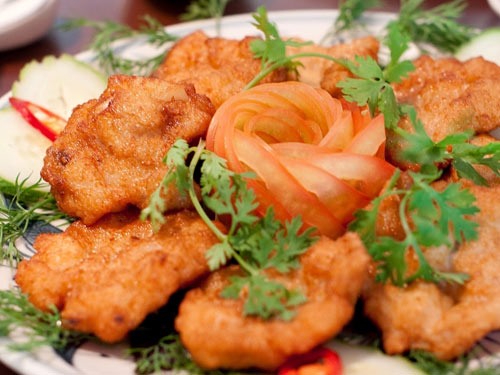 |
| Provincial specialty: Chả trứng mực (fried patties with squid eggs) is only available in the southernmost province of Việt Nam. —Photo savitour.vn |
Every coastal locality in Viet Nam offers visitors many culinary gifts from the sea, but the southernmost province of Cà Mau has a monopoly on squid eggs.
Chả trứng mực (fried patties made with squid eggs) has been a specialty of the province for a long time.
An old saying goes: Câu mực tuy cực mà vui/ Khoái ăn trứng mực, lui cui câu hoài. Roughly translated, it means: Catching squid is hard yet amusing/ Keen on squid eggs, then get hooked on catching squid.
The province’s fishermen search for squid at night. The catch is put in ice to keep it fresh. Next morning, ‘baskets’ of squid egg are taken out while squid flesh is dried in the sun.
A popular squid egg dish involves mixing it with duck eggs, minced pork and pig’s liver. The mixture is flattened out into small patties, which are sun dried and taken home.
Squid eggs are a ‘luxury’ because for every 10 to 12kg of fresh squid, you can only get 1kg of eggs.
The squid patties are deep fried or grilled. The creamy patty is perfectly paired with fresh herbs and rolled in bánh tráng (rice paper), and dipped in fish sauce seasoned with lime juice and hot pepper.
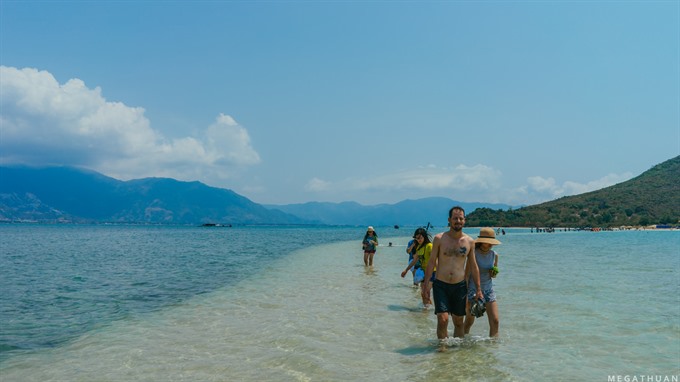 |
| Unique feature: Tourists wade over the undersea path connecting two islets in Điệp Sơn Island. VNS Photo Thúy Hằng |
Located in Vân Phong Bay (60km from Nha Trang City in the central province of Khánh Hòa), Điệp Sơn Island is an increasingly attractive destination for many visitors, drawn by its beaches and especially a beautiful “underwater sea path” connecting two islets.
Depending on the time of the visit, the path is either partially submerged in the crystal waters (in the morning during high tide) or completely dry and visible (in the afternoon during low tide).
The rustic island consists of three small separated islets and is home to about 100 households who use it as a base for fishing trips.
There are also many hidden coves and caves scattered across the island that are perfect for exploration by curious and determined visitors.— VNS


